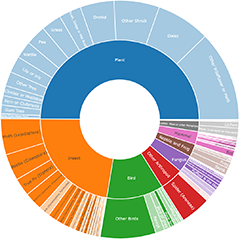Announcements
24 Sep 2025
Hi NatureMapr Data Collector app users,If you experience the following error when attempting to upload sightings from the NatureMapr Data Collector mobile app, please note the following known issue an...
Continue reading
NatureMapr moves to simpler, flatter national structure
Mobile App update and known issues
Discussion
Heinol
wrote:
2 hrs ago
Possibly a genus in the Russulales. There are numerous tiny chambers inside the fungus. The walls of each such chamber bear the spore-producing basidia.
zz - truffle
Heinol
wrote:
2 hrs ago
Perhaps a bleached Truncospora or perhaps a species of Trametes.
Truncospora ochroleuca
Heinol
wrote:
2 hrs ago
In fungi with such shelf-like fruiting bodies the underside may be pored, be packed with numerous ridges or with teeth or spines (in which the ends may be sharp or gently rounded) or be smooth. A smooth surface may have slight wrinkles or undulations or occasional warty bumps but you are still looking at what is essentially a smooth surface, continuous over minor rises – not at one packed with pores or protruding ridges, teeth or spines.
Some polypore species have very small pores, up to 10 per millimetre. To see such pores you may need to use a magnifying glass or hand lens. A close-up shot with a macro lens would also do the job – but even without that, if you enlarge a photo you my see the pores, depending on the quality of the photo. Here (https://www.neotropicalfungi.com/wp-content/uploads/2024/04/ANGE1885-Rigidoporus-microporus_risultato.jpg) is a photo of Rigidoporus microporus. In a description of this species you’d read that there are 6-9 pores per millimetre. One specimen has been turned to show the orange-brown underside and there are no obvious pores. If I enlarge this photo I still don’t see any pores but soon get into a pixelated image. Perhaps the original photo would show the pores – or perhaps the camera was not close enough to allow pores to show in any magnification of the original photo.
Sometimes a tiny-pored underside may show a slightly fuzzy look, since a smooth surface reflects light differently to a surface with numerous tiny pores. Your photo of the underside is a little blurry. If the edges had been sharp and the rest of the undersurface had been slightly fuzzy (but not obviously out of focus) I’d have suspected a pored surface.
Some polypore species have very small pores, up to 10 per millimetre. To see such pores you may need to use a magnifying glass or hand lens. A close-up shot with a macro lens would also do the job – but even without that, if you enlarge a photo you my see the pores, depending on the quality of the photo. Here (https://www.neotropicalfungi.com/wp-content/uploads/2024/04/ANGE1885-Rigidoporus-microporus_risultato.jpg) is a photo of Rigidoporus microporus. In a description of this species you’d read that there are 6-9 pores per millimetre. One specimen has been turned to show the orange-brown underside and there are no obvious pores. If I enlarge this photo I still don’t see any pores but soon get into a pixelated image. Perhaps the original photo would show the pores – or perhaps the camera was not close enough to allow pores to show in any magnification of the original photo.
Sometimes a tiny-pored underside may show a slightly fuzzy look, since a smooth surface reflects light differently to a surface with numerous tiny pores. Your photo of the underside is a little blurry. If the edges had been sharp and the rest of the undersurface had been slightly fuzzy (but not obviously out of focus) I’d have suspected a pored surface.
zz flat polypore - white(ish)
entom2
wrote:
4 hrs ago
Given the disparity of specimens which are patently different species attributed in iNat etc to this species, the disjunct distributions of their known populations (which may be a function of localised collecting effort), and importantly the lack of a comprehensive modern revision (requiring careful comparison with types), I would not be surprised if maculate-patterned species such as this prove to comprise several species. Let's hope that some competent person (or persons) will engage in the long-overdue revision of this interesting genus sooner than later. Cheers, Allen M. Sundholm.
Ethonion reichei
Significant sightings
- Galadistes pilligaensis at The Pilliga, NSW
- Callocephalon fimbriatum at Aranda, ACT
- Daphnandra micrantha at Pappinbarra, NSW
- Litoria raniformis
- Keyacris scurra at Penrose, NSW
- Callocephalon fimbriatum at Hughes, ACT
- Perunga ochracea at Yarralumla, ACT
- Keyacris scurra at Williamsdale, NSW
- Lichmera indistincta at Dunlop, ACT
- Keyacris scurra at Penrose, NSW
Top contributors
- AlisonMilton 17.1K
- trevorpreston 16.1K
- Hejor1 14.8K
- Tapirlord 12.1K
- MichaelBedingfield 10.8K
- Mike 10.8K
- RodDeb 10.5K
- kasiaaus 9.9K
- ConBoekel 9.8K
- KylieWaldon 9.1K
Top moderators
- MichaelMulvaney 61.2K
- Tapirlord 41.7K
- MichaelBedingfield 23.7K
- Liam.m 22.3K
- donhe 18.3K
- natureguy 15.7K
- ibaird 15.5K
- MatthewFrawley 12.2K
- AlisonMilton 11K
- plants 9K















































































































